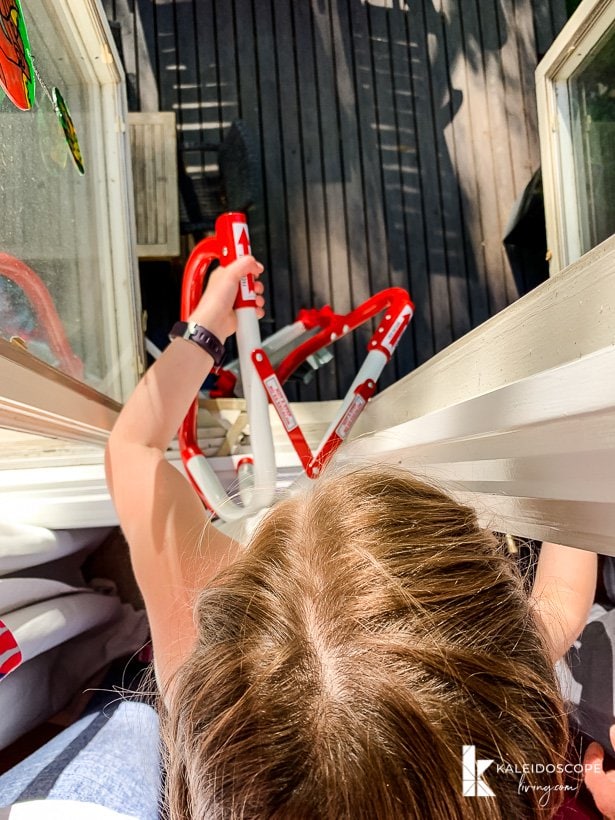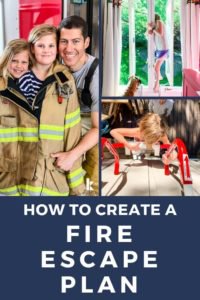How to Create a Fire Escape Plan for Your Home and Family
Every family needs a fire escape plan, especially if you have young kids! These tips explain how to create a fire escape plan for your home and family. Taking the time to create a home fire escape plan could literally save your lives!

If you find yourself wondering why I am taking a break from my usual DIY and home decor topics to write about how to create a fire escape plan, let me explain.
First of all, Joe is a firefighter, so our family probably thinks about fire more than most people. Secondly, it seems that only a teeny, tiny percentage of families out there have a fire escape plan. I mean, here we are a FIREFIGHTER family and we just finally got around to it. There can only be one reason for that–it isn't talked about enough! So, here I am… talking about it. It's important.
Here's the thing. Fire spreads quickly so every second counts if a fire breaks out in your home. You NEED escape plans to get your family out quickly if a fire erupts.
And while most adults could probably safely escape using the general knowledge they have floating around in their heads, kids are a whole other story. Imagine the complete and utter panic a child would feel if they woke up to flames and smoke detectors going off. What do you think their instincts would tell them to do? GO FIND MOM AND DAD. But that may be very dangerous for them to do.
The good news is that coming up with a fire escape plan and practicing it will greatly reduce the chance that they panic and do something dangerous. So, here are our tips for preparing your family and home for the possibility of a fire.
How to Create a Fire Escape Plan
Step 1: Make sure you have the right equipment.
Smoke Detectors:
Smoke detectors are so, so important. The sooner you are aware of a fire, the more likely it is that your family can safely escape.
At a minimum, make sure you have operational smoke alarms in every bedroom, but ideally, you should have multiple smoke detectors on every level of your home, including in hallways and your kitchen. If it's an option for you, have one or more of your smoke detectors tied into your alarm monitoring service. We use ADT and have the smoke detector in the hallway that connects all of the bedrooms tied into our alarm system.

If you have young kids, I strongly recommend using smoke detectors with high-intensity strobe lights, like these. Why? Because not all kids wake up from the sound of smoke detectors. You can learn more about that here if you are interested.
And if you are like most of the population (including us) and can't remember to test your smoke detectors every single month, test them when you DO remember. Also, change the batteries twice a year. We do it every time Daylight Saving Time begins and ends. That is pretty easy to remember :)
Escape Ladders:
If your home has two floors, you need to make sure that everyone can escape from the second-floor rooms if they need to. Escape ladders aren't very expensive. These are the ladders we bought for our second-floor bedrooms.

Once you get ladders, you have to actually take them out of the box, read the instructions and make sure you AND your family members know how to use them correctly. That means you actually need to do it and continue to practice it. More on that later.
Be sure to store the ladders near the windows they may need to be used for. They aren't going to do you any good if they aren't easily accessible.
Step 2: Identify your exits & meeting spot and draw up your fire escape plan.
Every adult and child in your home should be involved in creating your home escape plan. Walk through your house and make sure you can all identify at least 2 different routes out of the rooms in your home (some rooms, like our girls' bathroom, may only have 1 way out).
If you have kids, you also need to explain very clearly that it is very possible that they will have to exit by themselves. They have to be told not to come looking for your if their door feels hot or if they see smoke. You also need to tell them where to meet up outside the house if needed. Pick a spot far enough away from your house that it will be a safe distance from any fire, but close enough that your kids would be comfortable walking there by themselves if needed (like a neighbor's house, a stop sign, etc).
Then, draw out your fire escape plan and make a note of the two ways out of each room. Make sure your kids can explain it back to you. This doesn't have to be terrifying. You can make it fun. Maybe even have everyone sketch out their own version. You can find an easy-to-use template here. Be sure to also mark your meeting spot on your drawing.
Step 3: Practice, practice, practice.
Y'all, you gotta practice. You know the saying.. “If you don't use it, you lose it.” Plan to review your fire escape plan and practice using any escape ladders twice a year. We haven't gone so far as to do a practice drill in the middle of the night, but we do have our girls practice putting the ladders on their windows themselves. We have also made sure they can open the windows in their bedrooms themselves.
 |  |
We also have them practice climbing out their windows and down the ladders. Yes, it's kind of scary for all of us, but we'd rather them practice and be as comfortable as possible so that they are prepared in the off-chance we have a house fire at some point.
 |  |
So there you have it. I feel like I'm living the boy scout motto right now. Always be prepared. It's pretty simple :) If you want even more tips, check out this helpful article.
Wondering how I approach transforming rooms and spaces in our home? Check out Designer in a Binder®.
And if you want exclusive content and behind-the-scenes sneak peeks, be sure to subscribe before you head out!

Last Updated on February 24, 2022




